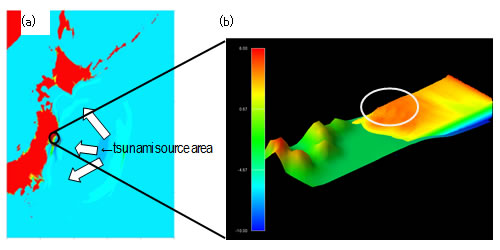Fujitsu and Tohoku University have developed a 3D Tsunami Simulator that will enable highly-precise tsunami forecasting.
The new simulator can replicate in fine detail the surge of water in urban areas as well as river surges caused by a tsunami. By combining a 2D tsunami-propagation simulation technology developed by Professor Fumihiko Imamura from the International Research Institute of Disaster Science in Tohoku University with Fujitsu’s 3D fluid simulation technology, researchers can accurately replicate the complex changes a tsunami undergoes as it interacts with coastal topography or buildings in urban areas, as well as the process of water surges in urban areas and rivers.
With the 3D tsunami simulator, the complex flows of the tsunami from its hypocenter source, as well as the behavior of wave breaks and overflow on the coastal areas can be replicated. As a result, it is hoped the damage caused by the impact force of the tsunami as it launches up over the breakwaters and then crashes down will be able to be more precisely estimated. Because such variables as wave height and flow velocity can be replicated using the 2D tsunami-propagation simulation technology, the time required for replication can be shortened compared to simulations using just the 3D fluid simulation technology.
For example, a simulation of a tsunami from its source area to urban areas on shore using only the 3D fluid simulation technology, would, even using a 10,000-node supercomputer system(5), require over 200 years to perform the calculations, making it infeasible. Using the newly developed 3D tsunami simulator, however, to precisely replicate an approximately 0.5m radius in a tsunami traveling over approximately 10 square kilometers, which is equivalent to one harbor or bay, would require approximately 160 hours of computing using a 10,000-node supercomputer. This therefore could be put to practical use as a solution that supports disaster mitigation efforts by forecasting the effects of measures taken to deal with tsunamis, such as by using coastal structures.
The goal of the research is to lead to the drawing up of a disaster mitigation plan modeled for western Japan. As part of those efforts, Fujitsu is planning to realize accurate tsunami damage forecasts that utilize the 3D tsunami simulator to predict tsunami behavior in fine detail, taking into consideration the three-dimensional force and behavior of tsunamis that occur in coastal and urban areas.





